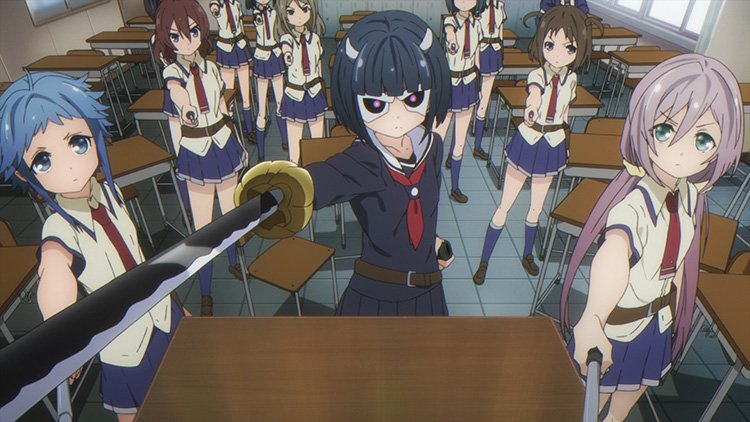Armed Girl’s Machiavellism Review
“We are the ones…who cut the path toward coexistence!”
Fudo Nomura is not your average high school student; he’s a tough delinquent with attitude who’s getting a fresh start in Aichi Coexistence Academy. The only problem is that this onetime all-girls school only admits boys if they learn to ‘co-exist’ which means wear makeup and behave like girls too – and Nomura is darned if he’s going to change or tone down his behaviour like the other male students. Enter the Supreme Five Swords, five fiery female students, armed to protect the other girls, each wielding a blade and practising a different blade style. Led by ogre-masked Rin Onigawara, the Five are charged with the task of knocking young Nomura into shape. Trouble is, he’s a skilled martial artist – and more than a worthy opponent. However, there was one opponent Nomura faced before he joined the academy, one so ruthless and tough that he was unable to beat them and suffered a painful and shameful defeat. Could it be that this fearsome opponent is now also a student at the academy? And who is the mysterious and shadowy Empress?

For a harem series with an ecchi twist, Armed Girl’s Machiavellism is surprisingly sparing with its fan service (refreshingly so, some might say) and has the advantage of a strong-willed and self-confident male protagonist. Fudo Nomura gradually wins over the support of the Five Swords as much by his refusal to fall for the seductive snares the girls set up for him as his prowess as a martial artist. And if you can overlook some of the annoying vocal mannerisms the Supreme Five Swords and their loyal seconds have been lumbered with, the young women have back stories that they eventually feel comfortable enough around Nomura to share.

However, if you try to unpack the story, it doesn’t quite make sense. Why are the adults in this school so ineffectual – or absent? Why are the boys compelled to act like girls – and how does Nomura get away with not doing so? (And why is this shown in such an inappropriate way, with the only other three male students we get to see being portrayed as stereotypical grotesque transvestite caricatures? Is it supposed to be funny?) Some of the ‘craziness’ of the story is quite entertaining, especially Warabi Hanasaka’s vast and fearsome pet bear/bodyguard, Kyo-bo. And there are some nice little comic touches, as when the two of the Swords competing for Nomura’s affections (oh no, they’re not!) drown their sorrows in what looks like red wine (for Mary) and sake (for Rin) becoming gradually more drunkenly incoherent in their protestations – until their sidekicks pointedly remind them (and us) that they’re drinking non-alcoholic beverages. But just when the story seems to be going somewhere at last, it starts spinning its wheels. The shonen manga (story by Yuuya Kurokami and art by Karuna Kanzaki) on which this is based is ongoing so, maybe the impulse to make an anime came a little too soon, before there was enough material for a twelve-episode series?

Attacks and different martial arts techniques come thick and fast, with the attack names spattered over the screen in English and kana. The girls are extremely violent in the way they treat the boys and each other. Blood spurts in every episode. Could the stabbing, torturing, poisoning etc. be seen as a metaphor for the cruel ways in which girls can interact with each other, especially in a boarding school situation? Or is that just way too deep for a shonen adventure romp?
Attractive (if somewhat generic) character designs by Shoko Takimotot predominate for the girls – but Nomura and the mysterious Empress get the greatest variety of more emotional expressions.

The US dub has the edge over the original Japanese voice track for Western viewers, most notably in the casting of Scott Gibbs (Sora in No Game, No Life) who makes Nomura much more straightforward and likable than Tasaku Hatanaka (Denki Kaminari in MHA) who favours a laid-back delivery which doesn’t fit the character so well. The dub script, by Marissa Lenti, is rather more fun than the subtitles and is able to play up some of the dafter elements, such as rapier-wielding Mary Kikakujo’s outbursts in French (Maggie Flecknoe) or her rivalry with straight-laced Rin Onigawara (Kira Vincent-Davis).

The soundtrack from Hiromi Mizutani of Team-MAX (Tanaka-kun is Always Listless) is something of a mixed bag: distractingly irrelevant in some places – and in others surprisingly on-target. The Opening Theme, “Shocking Blue” by Miku Itō and the Ending Theme “Decide” by Tenka Goken (sung by – of course – the main five female VAs) are pretty standard fare.
MVM has brought Armed Girl’s Machiavellism to Region 2 in a Blu-ray Collector’s Edition which has the OVA (Episode 13) and six art cards and a 240-page artbook (the latter two unseen). The Blu-rays are straightforward to navigate and the only extras are textless Opening and Ending and Japanese promos (which show some of the manga art).

Armed Girl’s Machiavellism turned out to be a more interesting watch than I’d at first feared – but I wouldn’t go further than that. Not sure where the Machiavellism came in, either – I think liked Kyo-bo the bear best, on reflection.


